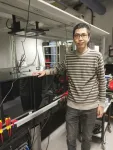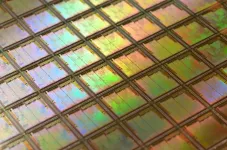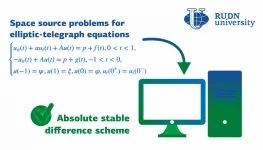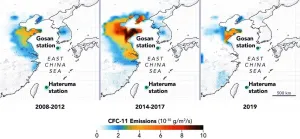Capturing free-space optical light for high-speed wifi
Plasmonic speed enhancements previously constrained to nanoscale phenomena are replicated on macroscopic devices
2021-02-11
(Press-News.org) DURHAM, N.C. - Visible and infrared light can carry more data than radio waves, but has always been confined to a hard-wired, fiber-optic cable. Working with Facebook's Connectivity Lab, a Duke research team has now made a major advance toward the dream of ditching the fiber in fiber optics.
While working to create a free-space optical communication system for high-speed wireless internet, the researchers also show that speed and efficiency properties previously demonstrated on tiny, single-unit plasmonic antennas can also be achieved on larger, centimeter-scale devices.
The research appears online Feb. 11 in the journal Optica.
In 2016, researchers from Internet.org's Connectivity Lab--a subsidiary of Facebook--outlined a new type of light detector that could potentially be used for free-space optical communication. Traditionally, hard-wired optical fiber connections can be much faster than radio wave wireless connections. This is because visible and near-infrared light frequencies can carry much more information than radio waves (WiFi, Bluetooth, etc).
But using these higher frequencies in wireless devices is difficult. Current setups use either LEDs or lasers aimed at detectors that can reorient themselves to optimize the connection. It would be much more efficient, however, if a detector could capture light from different directions all at once. The catch is that increasing the size of an optical receiver also makes it slower.
This was also the case for the Connectivity Lab's design. A spherical bundle of fluorescent fibers captured blue laser light from any direction and re-emitted green light that could be funneled onto a small receiver. While the prototype was able to achieve rates of two gigabits per second, most fiber optic internet providers offer up to 10 Gb, and higher-end systems can push into the thousands.
Looking for a way to speed up their free-space optical communication designs, the Connectivity Lab turned to Maiken Mikkelsen, the James N. and Elizabeth H. Barton Associate Professor of Electrical and Computer Engineering and Physics at Duke. Over the past decade, Mikkelsen has been a leading researcher in the field of plasmonics, which traps light on the surface of tiny nanocubes to increase a device's speed and efficiency at transmitting and absorbing light by more than a thousand times.
"The Connectivity Lab's prototype was constrained by the emissions lifetime of the fluorescent dye they were using, causing it to be inefficient and slow," said Mikkelsen. "They wanted to increase the efficiency and came across my work showing ultrafast response times in fluorescent systems. My research had only proven that these efficiency rates were possible on single, nanoscale systems, so we didn't know if it could scale up to a centimeter-scale detector."
All previous work, Mikkelsen explains, has been proof-of-principle demonstrations with a single antenna. These systems typically involve metal nanocubes spaced tens to hundreds of nanometers apart and placed just a handful of nanometers above a metal film. While an experiment might use tens of thousands of nanocubes over a large area, research showing its potential for superfast properties has historically cherrypicked just one cube for measurement.
In the new paper, Mikkelsen and Andrew Traverso, a postdoctoral researcher working in her laboratory, brought a more purposeful and optimized design to a large-area plasmonic device. Silver nanocubes just 60 nanometers wide are spaced about 200 nanometers apart, covering 17% of the device's surface. These nanocubes sit just seven nanometers above a thin layer of silver, spaced by a coating of polymer that is jam-packed with four layers of fluorescent dye.
The nanocubes interact with the silver base in a way that enhances the photonic capabilities of the fluorescent dye, causing a 910-fold increase in the overall fluorescence and a 133-fold emission rate enhancement. The superfast antenna also can capture light from a 120-degree field of view and convert it to a directional source with a record-high overall efficiency of 30%.
"Plasmonic effects have always been known to lose a lot of efficiency over a large area," said Traverso. "But we've shown that you can take attractive ultrafast emission features of a nanoscale device and recreate it on a macroscopic scale. And our method is very easily transferrable to fabrication facilities. We can create these largescale plasmonic metasurfaces in under an hour with pipettes and Petri dishes, just simple liquid depositions on metal films."
The overall effect of the demonstration is the ability to capture light from a large field of view and funnel it into a narrow cone without losing any speed. To move forward with this technology, researchers would need to piece several plasmonic devices together to cover a 360-degree field of view and once again include a separate interior detector. While there is work to be done, the researchers see a viable path forward.
"In this demonstration, our structure acts to efficiently relay the photons from a wide angle into a narrow angle without losing speed," said Mikkelsen. "We didn't integrate a regular fast photodetector like the Connectivity Lab did in their original paper yet. But we solved the major bottleneck in the design and the future applications are very exciting!"
INFORMATION:
This work was funded by Facebook and Air Force Office of Scientific Research (FA9550-15-1-0301, FA9550-18-1-0326).
CITATION: "Low-loss, Centimeter-Scale Plasmonic Metasurface for Ultrafast Optoelectronics," Andrew J. Traverso, Jiani Huang, Thibault Peyronel, Guoce Yang, Tobias G. Tiecke, and Maiken H. Mikkelsen. Optica, Feb. 11, 2021. DOI: 10.1264/OPTICA.400731
[Attachments] See images for this press release:
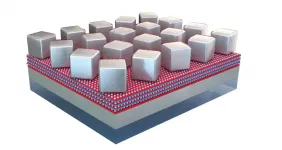
ELSE PRESS RELEASES FROM THIS DATE:
2021-02-11
A total of 1.1 million bitcoin were stolen in the 2013-2017 period. Given the current price for Bitcoin exceeding $40,000, the corresponding monetary equivalent of losses is more than $44 billion highlighting the societal impact of this criminal activity. The question arises how does the uncertainty in the Bitcoin market - measured by its volatility - respond to such cyberattacks.
A recently published research article from Dr. Klaus Grobys (University of Vaasa, Finland) in the well-known journal Quantitative Finance addresses this question.
In his study, he examined 29 hacking incidents that occurred in the Bitcoin market in the 2013-2017 period. A surprising result of this study is that Bitcoin volatility does not respond to hackings with a subsequent ...
2021-02-11
Research from the University of Kent, Goethe-University in Frankfurt am Main, and the Philipps-University in Marburg has provided crucial insights into the biological composition of SARS-CoV-2, the cause of COVID-19, revealing vital clues for the discovery of antiviral drugs.
Researchers compared SARS-CoV-2 and the closely related virus SARS-CoV, the cause of the 2002/03 SARS outbreak. Despite being 80% biologically identical, the viruses differ in crucial properties. SARS-CoV-2 is more contagious and less deadly, with a fatality rate of 2% compared to SARS-CoV's 10%. Moreover, SARS-CoV-2 can be spread by asymptomatic individuals, whereas SARS-CoV was only transmitted by those who were already ill.
Most functions in cells are carried ...
2021-02-11
A team of researchers studying the effectiveness of different types of face masks has found that in order to provide the best protection against COVID-19, the fit of a mask is as important, or more important, than the material it is made of.
The researchers, from the University of Cambridge, carried out a series of different fit tests, and found that when a high-performance mask - such as an N95, KN95 or FFP2 mask - is not properly fitted, it performs no better than a cloth mask. Minor differences in facial features, such as the amount of fat under the skin, make significant differences in how well a mask fits.
The results, published in the journal PLoS ONE, also suggest that the fit-check routine used in many healthcare settings has high failure rates, as minor leaks ...
2021-02-11
Current electronic components in computers, mobile phones and many other devices are based on microstructured silicon carriers. However, this technology has almost reached its physical limits and the smallest possible structure sizes.
Two-dimensional (2D) materials are therefore being intensively researched. One can imagine these materials as extremely thin films consisting of only one layer of atoms. The best known is graphene, an atomically thin layer of graphite. For its discovery, Andre Geim and Konstantin Novoselov received the Nobel Prize in Physics in 2010.
While ...
2021-02-11
Our world needs reliable telecommunications more than ever before. However, classic devices have limitations in terms of size and cost and, especially, power consumption - which is directly related to greenhouse emissions. Graphene could change this and transform the future of broadband. Now, Graphene Flagship researchers have devised a wafer-scale fabrication technology that, thanks to predetermined graphene single-crystal templates, allows for integration into silicon wafers, enabling automation and paving the way to large scale production.
This work, published in the prestigious journal ACS Nano, is a great example of a collaboration fostered by the ...
2021-02-11
During the first confinement (18 March to 10 May 2020), people who reported worse sleep quality during a night also reported an increase in negative mood, psychotic-type like experiences and somatic complaints on the next day. Furthermore, daily reports of deaths caused by Covid-19 predicted psychological symptoms on the same day and sleep quality the following night. This is the result of research carried out in three countries (Belgium, Hungary, Spain) under direction of Peter Simor with researchers at the Université libre de Bruxelles (ULB), Rebeca Sifuentes-Ortega, Ariadna Albajara Saenz, Oumaïma Benkirane, Anke Van Roy and Philippe Peigneux from the CRCN (Center for Research in Cognition and Neurosciences) and the UNI (ULB Neurosciences Institute) ...
2021-02-11
Personality traits such as conscientiousness or sociability are patterns of experience and behavior that can change throughout our lives. Individual changes usually take place slowly as people gradually adapt to the demands of society and their environment. However, it is unclear whether certain personality traits can also be psychologically influenced in a short-term and targeted manner.
Researchers from the universities of Zurich, St. Gallen, Brandeis, Illinois, and ETH Zurich have now investigated this question using a digital intervention. In their study, around 1,500 participants were provided with a specially developed smartphone app for three months and the researchers then assessed whether and ...
2021-02-11
A mathematician from RUDN University suggested a stable difference scheme for solving inverse problems for elliptic-telegraph and differential equations that are used to describe biological, physical, and sociological processes. The results of the study were published in the Numerical Methods for Partial Differential Equations journal.
Elliptic equations are a class of differential equations in partial derivatives that are used, among other things, to model time-independent processes. Telegraph equations are presented in a nonstationary form. They were initially obtained for a telegraph communication line, but today they are also used to model the movement of insects, the flow of blood ...
2021-02-11
PHOENIX -- A Mayo Clinic team, led by Rahmi Oklu, M.D., Ph.D., a vascular and interventional radiologist at Mayo Clinic, in collaboration with Samir Mitragotri, Ph.D., of Harvard University, report the development of a new ionic liquid formulation that killed cancer cells and allowed uniform distribution of a chemotherapy drug into liver tumors and other solid tumors in the lab. This discovery could solve a problem that has long plagued drug delivery to tumors and provide new hope to patients with liver cancer awaiting a liver transplant. The preclinical study results are published in Science Translational Medicine.
Dr. Oklu, study author and director of Mayo Clinic's ...
2021-02-11
Two international studies of a consortium including more than a dozen institutions the world over, including Empa, published today in the journal Nature show levels of CFC-11 emissions, one of many chlorofluorocarbon (CFC) chemicals once widely used in refrigerators and insulating foams, are back on the decline - less than two years after their shock resurgence in the wake of suspected rogue production in eastern China was widely publicized.
"The findings are very welcome news and hopefully mark an end to a disturbing period of apparent regulatory breaches", says Luke Western from the University of Bristol, a ...
LAST 30 PRESS RELEASES:
[Press-News.org] Capturing free-space optical light for high-speed wifi
Plasmonic speed enhancements previously constrained to nanoscale phenomena are replicated on macroscopic devices


